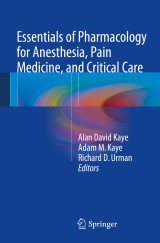Details

Essentials of Pharmacology for Anesthesia, Pain Medicine, and Critical Care
|
160,49 € |
|
| Verlag: | Springer |
| Format: | |
| Veröffentl.: | 20.11.2014 |
| ISBN/EAN: | 9781461489481 |
| Sprache: | englisch |
Dieses eBook enthält ein Wasserzeichen.
Beschreibungen
<p>In anesthesiology, pain medicine, and critical care, practitioners at all levels need help to stay current with the continually evolving drug knowledge-base and trainees need tools to prepare for in-training and board exams that increasingly test their knowledge of pharmacology. This practical book is aimed at both readerships. It features a unique and practical chapter on the United States Food and Drug Administration (FDA) “black box” warnings that describe what safety precautions should be taken with commonly used drugs. The editors and contributors are pharmacology experts representing a cross-section of clinical specialties and institutions in the United States and include pharmacologists, pharmacists, as well as physicians.</p>
Part I. Basic Pharmacologic Principles.- 1. Pharmacokinetics and Pharmacodynamics of Anesthetics.- 2. A Review of Mechanisms of Inhalational Anesthetic Agents.- 3. Pharmacokinetics, pharmacodynamics and physical properties of Inhalational agents.- 4. Principles of Total Intravenous Anesthesia.- 5. Perioperative Considerations in Pharmacology.- Part II. Drug Classes.- 6. Anesthetic Induction Agents.- 7. Analgesics: Opiate agonists, mixed agonist/antagonists and antagonists for acute pain management.- 8. Analgesics: Opioids for chronic pain management and surgical considerations.- 9. Nonopioid Analgesic and Adjunct Drugs.- 10. Benzodiazepines and muscle relaxants.- 11. Pharmacology of Local Anesthetics.- 12. Neuromuscular Blockers.- 13. Reversal agents.- 14. Drugs acting on the autonomic nervous system.- 15. Antihypertensives, diuretics and antidysrhythmics.- 16. Peripheral vasodilators.- 17. Nitric oxide and Pulmonary Vasodilators.- 18. Asthma and COPD agents.- 19. Hormones, Part 1: Thyroid and Corticosteroid Hormones.- 20. Hormones, Part 2: Insulin and Other glucose controlling Medications.- 21. Antacids, Gastrointestinal Prokinetics, And Proton Pump Inhibitors.- 22. Histamine modulators.- 23. Central Nervous System Stimulants.- 24. Anticoagulant drugs.- 25. Hemostatic Agents.- 26. BLOOD, BLOOD PRODUCTS, AND SUBSTITUTES.- 27. Antipyretics: Acetaminophen, Arachidonic Acid Agents, Cox1 And Cox2 Inhibitors.- 28. Antiemetic Agents.- 29. Antiepileptics agents.- 30. Neuropharmacologic agents for neurologic conditions.- 31. Chemotherapeutic Agents.- 32. Antimicrobial Agents.- 33. Herbals medications and vitamin supplements.- 34. Minerals and electrolytes.- 35. Disinfection agents and antiseptics.- 36. Psychopharmacologic agents and psychiatric drug considerations.- 37. Cocaine, Methamphetamine, MDMA and Heroin.- Part III. Clinical Subspecialties.- 38. Cardiac surgery.- 39. The Intensive Care Unit.- 40. Enteral and parenteral nutrition.- 41. Obstetrics.- 42. Pediatrics.- 43. Neurologic Surgery.- 44. Liver disease and liver transplantation.- Part IV. Special Topics.- 45. Black Box FDA warnings and legal implications.- 46. Drug-Induced QT Prolongation.- 47. Drugs and Cancer Propagation.- 48. Lipid Lowering Agents.- 49. Serotonin Syndrome.- Part V. New Vistas in Pharmacology.- 50. Novel Psychoactive Substances: synthetic cathinones and cannabinoid receptor agonists.- 51. New Vistas in Anesthetics, IV Induction Agents.- 52. New Vistas In Neuromuscular Blockers.- 53. Patient-Controlled Analgesia: The Importance of Effector Site Pharmacokinetics.- 54. Understanding anesthesia-induced memory loss.- 55. Novel Targets of Current Analgesic Drug Development.
<p>Alan David Kaye</p><p>Departments of Anesthesiology and Pharmacology,</p><p>LSU Health Sciences Center, New Orleans, LA, USA;</p><p>LSU Interim Hospital and Ochsner Kenner Hospital, New Orleans, LA, USA</p><p> </p><p>Adam M. Kaye </p><p>Department of Pharmacy Practice,</p><p>Thomas J. Long School of Pharmacy and Health Sciences,</p><p>University of the Pacific</p><p>Stockton, CA, USA</p><p> </p><p>Richard D. Urman</p><p>Department of Anesthesia,</p><p>Harvard Medical School;</p><p>Hospital Procedural Sedation Management and Safety,</p><p>Center for Perioperative Management and Medical Informatics,</p><p>Brigham and Women’s Hospital,</p><p>Boston, MA, USA</p><p>
<p>In anesthesiology, pain medicine, and critical care, practitioners at all levels need help to stay current with the continually evolving drug knowledge-base, and trainees need tools to prepare for in-training and board exams that increasingly test their knowledge of pharmacology. This practical book is aimed at both readerships. It features a unique and practical chapter on the United States Food and Drug Administration (FDA) “black box” warnings that describe what safety precautions should be taken with commonly used drugs. The editors and contributors are pharmacology experts representing a cross-section of clinical specialties and institutions in the United States and include pharmacologists, pharmacists, as well as physicians.</p>
All-in-one drug guide and review— Drugs by class, Subspecialty considerations, Basic principles, Special topics, Future directions Drug entries reflective of FDA “black box” warnings Concepts and medications frequently tested on standardized exams For daily consultation by practitioners, trainees and students in anesthesia, pain medicine and critical care
Diese Produkte könnten Sie auch interessieren:

Reumatología para el clínico

von: Manuel Robles San Román, Juan Carlos Cajigas Melgoza, Lucio Ventura Ríos, Lucio Ventura Editorial Alfil, S. A. de C. V.

36,99 €

Aktinische Keratosen - medizinisches Grundwissen und NEUE Therapieansätze (Carcinomata in situ)

von: Hellene von Waldgraben

9,99 €














